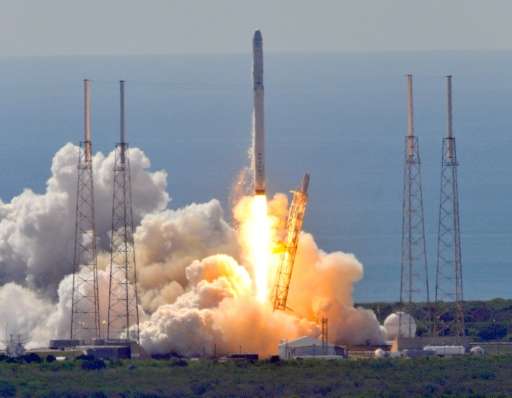Elon Musk envisions 'fun' but dangerous trips to Mars (Update 4)

SpaceX chief Elon Musk unveiled on Tuesday ambitious plans to establish a Mars colony by sending 100 humans at a time on massive spacecraft, possibly costing as low as $100,000 per person.
Taking the stage under a large globe of Mars at the International Astronautical Congress in western Mexico, Musk showed his vision for a giant rocket that would propel people to the Red Planet "in our lifetime."
He told reporters he was "optimistic" that the first human mission could leave Earth in 2024 and arrive several hundred million kilometres away on the Red Planet the following year.
Before that, SpaceX plans to send an unmanned Dragon cargo capsule as early as 2018.
"I think the first trips to Mars are going to be really, very dangerous. The risk of fatality will be high. There is just no way around it," Musk said. "It would basically be, 'Are you prepared to die?' Then if that's ok, then you are a candidate for going."
These risk-taking pioneers would open the way for others under Musk's vision, which one expert warned was "long on vision, short on detail."
"We need to go from these early exploration missions to actually building a city," Musk said to an overflow crowd at an expo center in the city of Guadalajara.
A futuristic video depicted his concept of an interplanetary transport system based on reusable rockets, a propellant farm on Mars and 1,000 spaceships on orbit, carrying about 100 people each.
The spacecraft would have a restaurant, cabins, zero-gravity games and movies.
"It has to be fun or exciting. It can't feel cramped or boring," he said.
'Affordable' ticket price
The South Africa-born Canadian-American entrepreneur said the plan would require a "huge public-private partnership," but did not announce any alliance with a government agency.
The first flight would be expensive but the aim is "making this affordable to almost anyone who wants to go," by dropping the price of a ticket over time from $200,000 to $100,000, Musk said.
"You can't create a self-sustaining civilization on Mars if the ticket price is $10 billion per person," he said.
While SpaceX was hit by a setback on September 1 when its Falcon 9 rocket, after several successful missions and vertical landings, exploded on the launch pad during a test in Florida, Musk said "this is just a small thing on a long road."
SpaceX is not alone in aspiring to travel to Mars.

The US space agency NASA, which is studying the effects of long-term space flight on the human body, has announced its own plans to send people to Mars by the 2030s.
Blue Origin, a company founded by Amazon boss Jeff Bezos, also envisions a Mars mission, but decades from now.
Costly, challenging
Experts warn that reaching Mars—225 million kilometers (140 million miles) from Earth on average—and living there requires major engineering feats and a massive budget.
John Logsdon, professor emeritus at George Washington University's Space Policy Institute, said Musk's presentation was "long on vision, short on detail."
Musk did not explain in detail how he would get the "billions of dollars that would be required to put the vision into reality."
The plan also faces technical challenges, such as refueling in orbit, which has never been done, and building fuel depots on Mars.
Chris Carberry, chief executive of Explore Mars Inc, a non-profit promoting the goal of sending humans to the planet within two decades, said a mission of just three to six people would cost between $80 billion and $120 billion.
Musk's presentation is "very inspiring, aspirational, but I think it's going to be very challenging to be able to accomplish this in 10 years."
"I think it's probably more likely we're going to send a smaller mission to first figure out if people can live on Mars before we send 100 people there at a time," he said.
Musk said the rocket would take a spaceship into orbit, release it and land back on Earth to pick up a fuel tanker, which it would fly to the craft to fuel its journey to Mars. The trip would one day take as little as three months, or even less than one month.
Once on Mars, humans would have to install a plant to produce propellant by using the planet's methane resources to fuel the spacecraft for its return to Earth.
Musk posted a photo on Twitter this week showing the first test-firing of "the Raptor interplanetary transport engine."
Space competition
SpaceX has achieved engineering breakthroughs, notably by successfully landing the Falcon 9 rocket upright, which could cut space travel costs by making rockets reusable.
Blue Origin has also built a rocket that lands vertically and is working on a taller launcher called New Glenn, but the company is focusing on sending people to Earth's low orbit for now.
"We want to have millions of people living and working in space in a decades timeframe if they want to," Blue Origin president Rob Meyerson told AFP.
© 2016 AFP





















